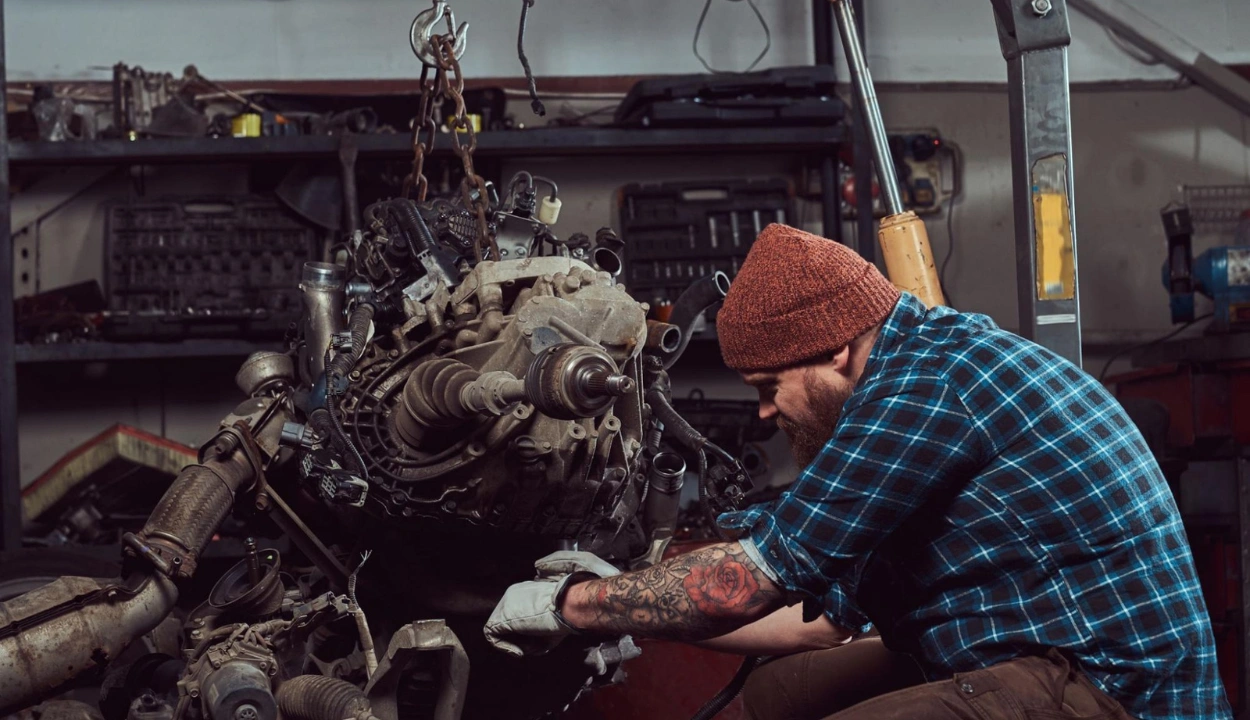Outsourced vs in House Equipment Maintenance: What’s Best
Maintenance holds significant importance for construction industries as it plays a major role in extending equipment lifespan, which is the number one priority for construction businesses.
To reap the desired results, it's imperative to select the right approach.
Whether outsourcing or in-house, both have their privileges and drawbacks, but only one can be the right fit for your business.
Before you make any decision, read the article till the end to ensure you don't miss out on any information necessary for making the right choice.
Why is Equipment Maintenance Important?

Equipment maintenance is crucial, especially in the construction industry, to keep machines working reliably and efficiently.
Regular maintenance helps identify potential issues before they become major problems. It also reduces the likelihood of unexpected breakdowns and downtime.
This not only extends the lifespan of equipment but also keeps it operating at full capacity, which in turn saves money and resources in the long run.
Proper maintenance provides workplace safety by preventing malfunctioning equipment from causing accidents and injuries.
Regular checks ensure that all safety features are functioning correctly, reducing the risk of accidents.
Types of Maintenance
The following are the most common types of maintenance used in the construction and other industries:
- Preventive Maintenance: Regular checks to stop problems before they happen.
- Corrective Maintenance: Performed when an issue is noticed and needs fixing.
- Predetermined Maintenance: Sticking to the factory's schedule.
- Condition-Based Maintenance: Triggered by specific conditions or situations indicating maintenance is necessary.
- Predictive Maintenance: Data-driven maintenance based on preset conditions to predict and prevent issues.
- Reactive Maintenance: Conducted after a total breakdown or failure occurs.
What is In-house Equipment Maintenance?
In-house equipment maintenance involves managing and servicing machinery within the organization.
It includes a dedicated team fixing and maintaining equipment on-site.
This approach offers flexibility in scheduling maintenance, swift issue resolution, and potential cost savings.
Customization of maintenance to fit the company's needs and ensure everything runs safely.
However, it does require the company to invest in training, tools, and other necessities to ensure the maintenance team can perform their duties effectively.
According to Field Circle the net savings through in-house maintenance amount to about $60,000, which represents 1.1% of the benefit-cost ratio of the total $570,000 spent.
Pros & Cons of In-house Maintenance
Pros
- Maintaining Control: Handling maintenance tasks in-house gives business owners complete control over the process. This allows tasks to be executed exactly as desired while meeting specific standards. It promotes smooth collaboration by fostering good communication, ensuring everyone is aligned with the same goals and priorities.
- Facility Familiarity: In-house employees possess thorough knowledge of the facility due to their long tenure, enabling them to understand the maintenance needs and perform tasks efficiently. Consequently, they can promptly address issues using their expertise.
- Opportunity for Employee Development: When a company manages maintenance tasks with its staff, it provides them with opportunities for learning and growth. Investing in training enables employees to take on additional tasks and develop specialized skills, enhancing morale, job satisfaction, and fostering a culture of continuous learning and improvement.
- Prevention of Duplication of Roles: In-house maintenance helps prevent duplication of management roles and responsibilities that may occur when working with external contractors. Clear delineation of responsibilities facilitates efficient task completion without redundant efforts.
Cons
- Higher Costs Burden: Establishing and maintaining an in-house maintenance team can be costly, encompassing expenses such as recruitment, training, salaries, benefits, and equipment.
- Limited Expertise and Resources: Despite efforts to develop skills, the in-house team may lack the requisite expertise for complex tasks, resulting in inefficiencies and potential errors.
- Staffing Challenges: Managing changes in staffing, turnover, and skill shortages can disrupt operations and divert managerial focus from core business objectives. Maintaining team morale amidst these challenges adds complexity to management efforts.
What is Outsourced Equipment Maintenance?
Outsourced equipment maintenance refers to the practice of hiring external contractors or service providers for heavy equipment maintenance.
Organizations opt for outsourcing to leverage specialized expertise in maintenance tasks such as equipment repairs, facility management, or technical support.
These external providers are contracted to perform specific tasks based on service-level agreements or contracts.
Utilizing external expertise, companies can ensure that their equipment remains in good condition while they concentrate on their core tasks.
The net savings through outsourced maintenance amount to approximately $130,000, which constitutes 1.48% of the benefit-cost ratio out of the total expenditure of $270,000.
Pros & Cons of Outsourced Maintenance

Pros
- Cost Savings: Cutting costs is often a primary objective for organizations, and outsourcing equipment management can significantly contribute to this goal. By hiring outsourced professionals, organizations can avoid expenses associated with in-house employees, such as wages, benefits, and training costs. This helps them utilize resources more efficiently and invest in other areas of their operations.
- Access to Industry-Leading Specialists: Outsourcing equipment management provides access to several industry-leading specialists with diverse maintenance skills and knowledge. These professionals bring valuable insights and innovative approaches for effective maintenance. They offer specialized expertise without the need for extensive training or skill development within the organization.
- Flexibility: Outsourced maintenance professionals are more adaptable and flexible in adjusting to the evolving needs of businesses. They can efficiently manage facility expansions, upgrades, and changes while keeping operations running smoothly.
- Access to Industry-Leading Technology: Outsourced maintenance experts utilize the latest tools and technology to deliver high-quality service and results. They stay updated on advancements in their field, such as advanced equipment maintenance software and tools. This helps prolong the lifespan of equipment, prevent breakdowns, and minimize reactive maintenance.
Cons
- Loss of Control: Outsourcing may lead to a reduced level of control over maintenance processes. Since vendors may not perfectly align with a business's specific needs and priorities, challenges may arise in managing scheduling, setting priorities, and making critical decisions.
- Communication Problems: When working with external vendors, effective communication can sometimes be challenging. This can result in issues like misunderstandings or delays, which may disrupt maintenance schedules and hinder effective problem-solving.
- Risk of Dependency: Over-reliance on external experts for equipment management can lead to a decline in the skills of your team over time. Heavy reliance on external providers, coupled with any cessation of their services due to issues, can leave a business vulnerable.
- Long-Term Costs: Although outsourcing may initially save money, it can result in long-term expenses. The fees paid to the vendor accumulate over time, and unexpected expenses such as emergency repairs can further increase overall costs.
Final Thoughts
Deciding what's best for your organization involves comparing the pros and cons of in-house versus outsourced maintenance.
There isn't one right answer; it depends on what your business needs.
In-house maintenance might help your business grow, while hiring outsourced experts can increase ROI during improvement phases.
Using construction equipment maintenance software can also simplify operations as it offers a valuable solution for improving your maintenance routine.
The main thing is to pick what matches your goals, whether that's using your team, hiring help, or using new technology.
FAQs
Why is Equipment Management so important?
Equipment management can offer numerous benefits to companies, including fewer breakdowns and less downtime. It prevents malfunctions from small tools to heavy machinery, resulting in a safer working environment for employees as well.
What are the Main Differences Between In-House and Outsourced Maintenance?
In-house maintenance refers to equipment maintenance done by company staff within the organizational boundaries, while outsourced maintenance involves hiring external experts to handle equipment maintenance tasks.
In-house vs. outsourced Maintenance, which is better?
Both methods have their advantages, and both are beneficial in their ways. No clear verdict can be given as to whether one is better than the other.
How can I Choose the Best Equipment Management Maintenance approach?
It highly depends on the goals, standards, and needs of the specific organization. Evaluating the pros and cons of both approaches in light of your organization’s priorities can help make an informed decision.
Transform Your Equipment Management












